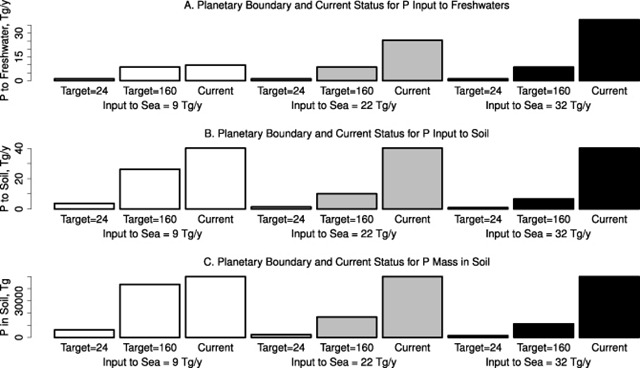Graph of the Day: Planetary Boundaries and Status of the Phosphorus Cycle, 2010
Planetary boundaries and current status of the phosphorus (P) cycle. (A) Planetary boundary and current status for P input to freshwaters from terrestrial ecosystems, Tg y–1. (B) Planetary boundary and current status for P input to terrestrial soils, Tg y–1. (C) Planetary boundary and current status for P mass in terrestrial soils, Tg. In each bar plot, white bars are results if P flow to the sea is 9 Tg y–1, gray bars are results if P flow to the sea is 22 Tg y–1, and black bars are results if P flow to the sea is 32 Tg y–1. For each rate of P flow to the sea, the first bar is the planetary boundary for the low target of 24 mg m–3, the second bar is the planetary boundary for the high target of 160 mg m–3, and the third bar is the current status. Abstract: Phosphorus (P) is a critical factor for food production, yet surface freshwaters and some coastal waters are highly sensitive to eutrophication by excess P. A planetary boundary, or upper tolerable limit, for P discharge to the oceans is thought to be ten times the pre-industrial rate, or more than three times the current rate. However this boundary does not take account of freshwater eutrophication. We analyzed the global P cycle to estimate planetary boundaries for freshwater eutrophication. Planetary boundaries were computed for the input of P to freshwaters, the input of P to terrestrial soil, and the mass of P in soil. Each boundary was computed for two water quality targets, 24 mg P m–3, a typical target for lakes and reservoirs, and 160 mg m–3, the approximate pre-industrial P concentration in the world’s rivers. Planetary boundaries were also computed using three published estimates of current P flow to the sea. Current conditions exceed all planetary boundaries for P. Substantial differences between current conditions and planetary boundaries demonstrate the contrast between large amounts of P needed for food production and the high sensitivity of freshwaters to pollution by P runoff. At the same time, some regions of the world are P-deficient, and there are some indications that a global P shortage is possible in coming decades. More efficient recycling and retention of P within agricultural ecosystems could maintain or increase food production while reducing P pollution and improving water quality. Spatial heterogeneity in the global P cycle suggests that recycling of P in regions of excess and transfer of P to regions of deficiency could mitigate eutrophication, increase agricultural yield, and delay or avoid global P shortage.
Stephen R Carpenter and Elena M Bennett, Reconsideration of the planetary boundary for phosphorus, Environ. Res. Lett. 6 (January-March 2011) 014009 doi:10.1088/1748-9326/6/1/014009
